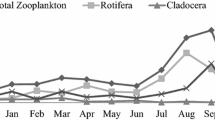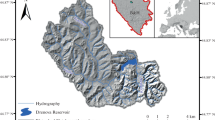Abstract
Studies were conducted in two medium reservoirs viz. Dhaura and Baigul of Uttarakhand from June 2006 to May 2007 to assess the present species composition of phytoplankton, zooplankton, macro- benthos (molluscs) and fishes. The study revealed a moderate to fair plankton, molluscs and fish diversity in both reservoirs. During study period, 30 species of phytoplankton, 15 species of zooplankton, 9 species of molluscs and 33 species of fishes were recorded from the experimental water bodies. The average plankton population in terms of phytoplankton and zooplankton was found in the range of 28,201–218,229 and 952–11,581 U/l from Dhaura and Baigul reservoirs, respectively. Microcystis aeruginosa belonging to group Cyanophyceae was most dominant species among phytoplankton. The macro benthic invertebrate diversity in the form of molluscs was comprised of 9 species from these reservoirs. The fish diversity was represented by 33 species comprising 8 species of carps, 14 species of cat fishes/other carnivorous fishes and 11 species of weed fishes. Study of various biological parameters reveal that these reservoirs are moderately productive and if managed properly, the production at all trophic levels can be enhanced. The details of the observations of the above work are described in the paper.


Similar content being viewed by others
References
Desai VR (2006) Reservoir fisheries. In: Rao TSS, Natarajan R, Desai BN, Narayana Swami G, Bhatt SR (eds) Handbook of fisheries and aquaculture. Directorate of Information and Publications of Agriculture, Indian Council of Agricultural Research, New Delhi, pp 173–195
Schiemer F and Duncan A (1987) The significance of the ecosystem approach for reservoir management. In: Proceedings of a workshop on reservoir fishery management and development in Asia, Nepal, IDRC 264 C 183–194
Pennak RW (1978) Fresh- water invertebrates of the United States, 2nd edn. Wiley-Interscience Publication, New York, p 803p
American Public Health Association (1995) In: Michel JTEG, Arnoald RD, Hoak RD, Rand MC (eds) Standard methods for the examination of water and waste water, 19th edn. American Public Health Association Society Pub, Washington DC, p 874
Ranson JD, Dorris TC (1972) Analyses of benthic community structure in a reservoir by use of diversity indices. Am Midl Nat 82(2):434–447
Salim M, Ahmed Z (1985) Environmental factors and planktonic communities of Baigul and Nanaksagar reservoirs Nainital. J Bombay Nat Hist Soc 82:13–23
Deorari BP (1993) Productive potential of a manmade reservoir of Tarai of Uttar Pradesh with particular reference to fish fauna. Ph.D. Thesis, Submitted to Rohilkhand University, Bareilly, p 291
Lewis WM Jr (1978) Dynamics and succession of the phytoplankton in a tropical lake. J Ecol 66:849–880
Vijverberg J, Arunachalam M, Amarasinghe PB (1987) Seasonal dynamics of copepods and cladocerans in five Srilanka reservoirs. In: Proceeding of workshop on reservoir fishery mangement and development in Asia, Nepal. IDRC. 264C 58–68
Fernando CH (1980) The fishery potential of manmade lakes in South East Asia and some strategies for its optimization. Biotrop Anniversary Publication Boger, Indonesia, pp 25–38
Sharma AP (1980) Phytoplankton primary production and nutrient relations in Nainital lake. Ph.D. Thesis, Kumaon University, Nainital. p 317
Singh CS, Sharma AP, Deorari BP (1990) Analysis of plankton population in relation to fisheries in Nanaksagar reservoir. In: Proceeding national seminar on recent advances Hydrobiology, Devi Ahalya University, Nainital, p 21–29
Rawat HS (1991) Studies on the limnology and fisheries of Tumaria reservoir (Nainital). Ph.D. Thesis, Kumaun University, Nainital, p 188
Sugunan VV (1995) Reservoir fisheries of India. FAO Tech Pap 345:423p
Lehman PW (2000) The influence of climate on phytoplankton community biomass in San Francisco Bay Estuary. Limnol Oceanogr 45(3):580–590
Sharma AP, Jaiswal SJ, Negi N, Pant MC (1982) Phytoplankton community analysis in lakes of Kumaon Himalaya. Arch Hydrobiol 93(2):173–193
Vashist HS, Sharma BK (1976) Seasonal abundance of rotifer population in freshwater pond in Ambala city (Haryana). Ind J Zool Soc India 28:1–12
Kulshrestha SK, Adholia UN, Khan AA, Bhatnagar A, Saxena M, Baghail M (1989) Community structure of planktons and macrozoobenthos, with reference to pollution in the River Khan (India). Int J Environ Stud 35:83–96
O’Reilly M Catherine (2006) Seasonal dynamics of periphyton in large typical lake. Hydrobiol 553:293–301
Gupta SD (1976) Macrobenthic fauna of Loni reservoir. J Indian Fish Assoc 8:49–59
Kaul, V. and Pandit, A. K. (1981) Benthic communities as indicator of pollution with reference to wetland ecosystem of Kashmir. In Proceedings of theWHO workshop on biological indicators as indices of environmental pollution. Cent Bd Prev Cont Water Pollut Osman Univ Hyderabad India, p 33–52
Rao KS, Das NK and Pandya SS (1985) Community structures of benthic macro invertebrates and their utility as indicator of pollution in river Khan. In: Proceeding Nat Symp Pure Appl Limnol Bull Bot Soc Sagar, Indore, India, p 114–119
Sunder S, Vass KK (1988) Seasonal dynamics of benthos in some Kashmir lakes. Proc Nat Acad Sci India 58(1):193–203
Mohan M (2005) Benthic macro-biota in Gaula river Kumaon Himalaya. J Indian Fish Assoc 32:49–67
Medeiros ESF, Ramos RTC, Ramos TPA, Silva MJ (2006) Spatial variation in reservoir fish assemblages along semiarid intermittent river, Curimatau River, Northeastern Brazil. Rev Biol Cienc Terra 1–2:29–39
Nelson JS (1994) Fishes of the world, 3rd edn. John Wiley & Sons, New York
Oliviera EF, Goulart E, Minte-Vera CV (2004) Fish diversity along spatial gradients in the Itaipu reservoir, Parana Brazil. Braz J Biol 64(30):1–16
Johal MS, Rawal YK (2005) Key to the management of Western Himalayan hill streams in relation to fish species richness and diversity. Hydrobiol 532:225–232
Arenas F, Sanchez I, Hawkins SJ, Jenkins SR (2006) The invisibility of marine algal assemblages-role of fuctional diversity and identity. Ecology 87(11):2851–2861
Santhanam P, Perumal P (2003) Diversity of zooplankton in Parangipettai coastal waters, South East of India. J Mar biol Assoc India 45(2):144–151
Akin-Oriola GA (1999) Cumulative impact of effluents on plankton dynamics in Awba reservoir, Ibadan. Trop Freshw Biol 8:1–15
Caley MJ, Schluter D (1997) The relationship between local and regional diversity. Ecology 78(1):70–80
Dunstan KP, Johnson CR (2006) Linking richness, community variability and invasion resistance with patch size. Ecology 87(11):2842–2850
Baattrup- Pedersen A, Riis T (1999) Macrophyte diversity and composition in relation to substratum characteristics in regulated and unregulated Danish streams. Freshw Biol 42(2):375–385
Varshney PK, Jaiswar AK, Prakash C (2006) Intertidal benthic biodiversity of deteriorated Gorai creek, Mumbai (Bombay) coast India. Environ Ecol 245(3):646–650
Ferreira FC, Petrere M Jr, Rio Claro SP (2007) Anthropic effects on the fish community of Rbeirao Claro Brazil. Braz J Biol 67(1):1–16
Freitas CE, Petrere M Jr (2001) Influence of artificial reefs on fish assemblage of Barra Bonita reservoir (Sao Paulo, Brazil). Lakes reserv 6(4):273–278
Carol J, Benejam L, Alcaraz C, Vila Gispert A, Zamora L, Navarro E, Armengol J, Garcia-Berthou E (2006) The effects of limnological features on fish assemblages of 14 Spanish reservoirs. Ecol Freshw Fish 15(1):66–77
Tawari-Fufeyin P, Ekaye SA (2007) Fish species diversity as indicator of pollution in Ikpoba river, Benin city, Nigeria. Rev Fish Biol Fish 17(1):21–30
Bhukaswan T (1980) Management of Asian reservoir fisheries. FAO. Fish Tech Pap 207:69
Author information
Authors and Affiliations
Corresponding author
Rights and permissions
About this article
Cite this article
Mishra, A., Chakraborty, S.K., Jaiswar, A.K. et al. Comparative Biodiversity of Two Medium Reservoirs of North India. Natl. Acad. Sci. Lett. 37, 423–430 (2014). https://doi.org/10.1007/s40009-014-0263-2
Received:
Revised:
Accepted:
Published:
Issue Date:
DOI: https://doi.org/10.1007/s40009-014-0263-2




